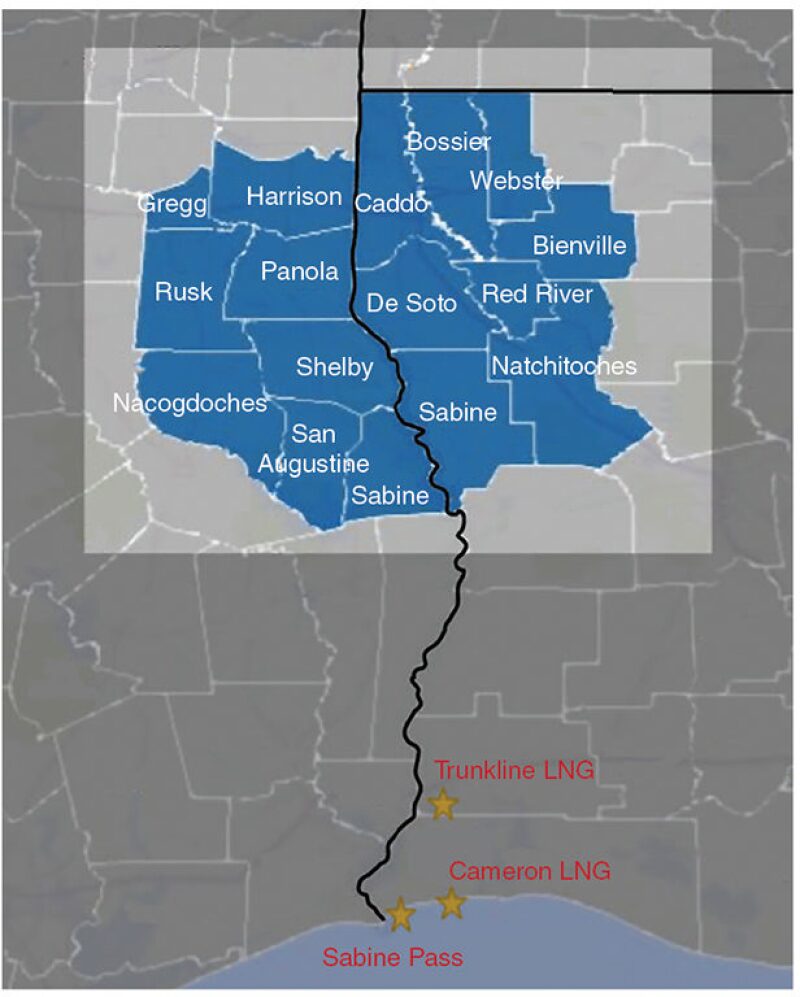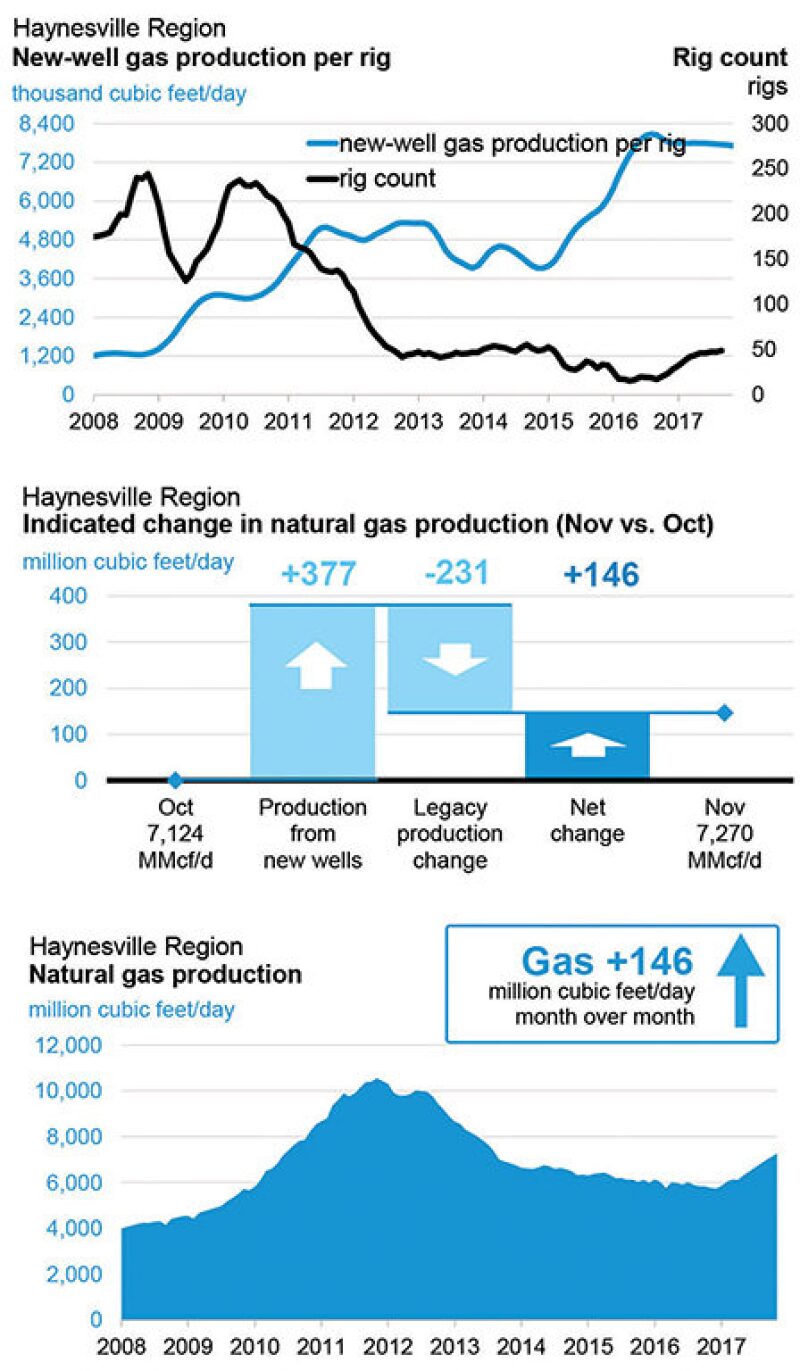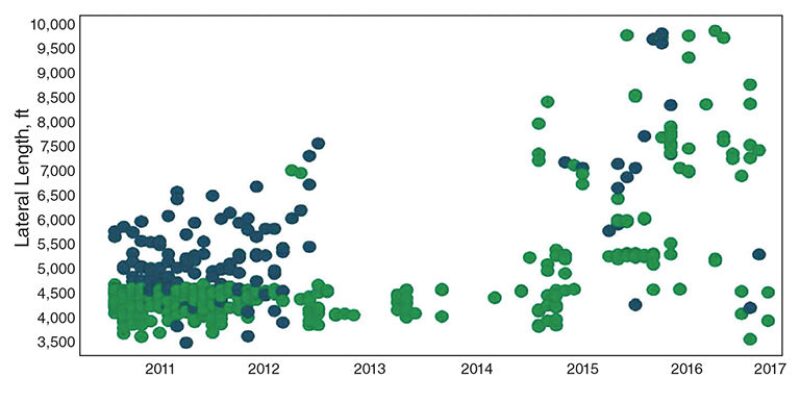What was once old is now new again in US natural gas production. Once a crown jewel of shale in the US, the Haynesville has seen a resurgence in activity after a steady drop. Now, as natural gas consumption increases and the oil price remains low, companies are taking advantage of a potentially valuable opportunity in the area.
Located in east Texas and northern Louisiana (Fig. 1) the Haynesville was the largest US producer of shale gas. In November 2011, it averaged a record high production of 10.4 Bcf/D—but as natural gas prices decreased in the years leading to the oil price downturn, other plays in the Appalachian region of the US such as the Marcellus and the Utica began to surpass it in production. By 2015, shale gas production in relatively liquids-rich areas such as the Eagle Ford and the Permian were also producing more than the Haynesville.

The demise of the Haynesville appeared to be short-lived, though. In the past 18 months, the US Energy Information Administration (EIA) noted significant increases in drilling activity and well production rates, which have raised overall natural gas production in the region. Natural gas production reached 6.9 Bcf/D in September after remaining near 6.0 Bcf/D on average for the past 3 years.
Beyond the Numbers
Fig. 2 highlights some of the trends in the Haynesville. The EIA projected natural gas production to increase by 146 MMcf/D from October to November 2017. Rig count has nearly doubled from 2015 to the end of 2017.

A drop in well costs has helped drive the surge in activity. In 2014, the Haynesville had the most expensive costs in the US primarily because of the challenges its fuel-bearing rocks presented. The formations were among the deepest in the country, with some as deep as 15,000 ft. In the Appalachian region, wells are in areas where formations range from 2,000- to 12,000-ft depth. The shale formation thickness in the Haynesville is slightly narrower than other US shale plays as well, ranging from 100 to 350 ft.
In addition, the high pressure and temperature conditions led to stimulation treatments consisting of high-strength proppant and more thermally stable fluids. These fluids consisted of large polymer loadings of guar and sometimes derivatized guar gelling agents. Higher-quality resin-coated and ceramic proppants were commonly pumped as the primary proppant, increasing costs and forcing companies to adopt a strategy of “quality over quantity” in terms of production volumes (SPE 187315).
However, with the price of oil dropping from more than $100/bbl to around $60/bbl in 2014, companies began focusing on natural gas production, looking at methods and strategies that could make extraction less cost-prohibitive. These methods included longer laterals, the use of minimal casing and liner, multipad drilling, and completion technology improvements such as increased proppant volumes, and a shift to hybrid fluid systems. By 2016, the EIA reported that average well drilling and completion costs for some onshore plays had dropped by as much as $3 million per well.
Increased lateral length is one of many factors helping to optimize Haynesville completions. Prior to 2015, most Haynesville wells in Louisiana were limited to 4,500-ft laterals, and the dimensions of the Louisiana sections limited the total depths of the wells. But now, operators can drill 7,500- to 10,000-ft laterals in the area, barring lease restrictions. Fig. 3 shows the increase in lateral length for various wells from 2011 to 2017.

The primary benefit of improved lateral technology was that operators did not need to drill separate vertical sections to achieve a long lateral length. This did not come without its own challenges, however: The higher frictional pressures that often come with longer laterals can complicate plug drillout operations, possibly leading to a lockup of coiled tubing. Cadotte et al. wrote that dissolvable plug technology helps work around this issue, as it helps reduce the risks and costs associated with using extended-reach fracture plugs.
Ben Hunter said the drop in well costs has made a significant difference in Covey Park Energy’s operations in the area. He said the company can utilize an aggressive completion design and still not spend as much money as it would have in years past.
“That changed everything,” said Hunter, general manager of operations at Covey Park Energy. “Yeah, we’ve gotten better at developing the resources, especially as our completion strategy has evolved to attract more gas, but the economics are really influenced most by costs. We’re drilling and completing wells for 20% less than what other operators were drilling and completing these wells for in 2010, but we’re using four times the amount of proppant they were.”
Companies in Operation
Covey Park has become one of the largest acreage holders and producers in the Haynesville and Bossier shale, which is also located in northern Louisiana. In November 2016 it acquired approximately 90,000 net acres spanning across three counties (Panola, Nacogdoches, and San Augustine) in east Texas and three parishes (DeSoto, Bossier, and Sabine) in northern Louisiana. Three months later, it spent $465 million for additional acreage from Chesapeake Energy.
The company has focused primarily on the acquisition and exploitation of long-life reserves in what it calls the Ark-La-Tex (Arkansas, Louisiana, and Texas) region since its founding in June 2013. Hunter said Covey Park’s leadership became familiar with the development of the Haynesville through its previous work with Exco Resources, which is currently running four rigs in the play and plans to spud a total of 38 gross operating wells by the end of 2017. He said Covey Park saw the possibility of a Haynesville resurgence after Encana refractured one of its low-producing wells in 2014, boosting gas production from an average of 100 Mscf/D to approximately 2.7 MMscf/D in a 30-day period.
“They stimulated four times more the amount of proppant than any other operator has in the play to date, and the performance of that well really caught our attention. We quickly saw the path from taking your recovery factors from 10–14% of the gas in place to 40–50% of the gas in place. The associated value of that is huge,” Hunter said.
Covey Park is far from the only company bolstering its Haynesville assets. Despite its sale of acreage to Covey Park and a subsequent sale of 78,000 net acres to Indigo Minerals in December 2016, Chesapeake still holds more than 250,000 net acres in the Haynesville with 1,200 future well locations. And in its 1Q 2017 report, Exco announced that it would spend $122 million of its $158 million capital budget in developing the Haynesville and Bossier shales. Its drilling program includes extended laterals up to 10,000 ft in length and larger completions with an average of 3,500 lb of proppant per lateral foot.
“Our focus is clearly on north Louisiana,” Exco chief operating officer Harold Jameson said in a conference call. “The Haynesville play has been reenergized, as industry and Exco has significantly enhanced returns by shifting to longer laterals and modifying completion designs to include higher levels of proppant, higher volumes of fluid, and tighter cluster spacing to deliver higher fracture intensity.”
QEP Resources also expects to refracture 30 wells in the Haynesville by the end of 2017, an increase from the 20 wells it had originally contemplated. So far, the program has exceeded expectations, with eight new refractures delivering an average gross production rate of 16.0 MMcf/D of natural gas per well. The company said it had increased gross Haynesville production by approximately 146 MMcf/D over the past year, and that at one point it was averaging nearly 200 MMcf/D, its highest production level from the region in 4 years.
QEP’s net production in the Haynesville and the Cotton Valley in east Texas this year increased approximately 35% from 1Q to 2Q, and 18% from 2Q to 3Q. Its 216.6 MMcf/D average in 3Q is 63% higher than at this time last year.
Demand for natural gas may continue to help increase interest in the region. The EIA is projecting an increase in natural gas consumption from 73.06 Bcf/D in 2017 to 76.8 Bcf/D in 2018. It also projected an increase in the annual average of the Henry Hub natural gas spot price from $3.01/MMBtu in 2017 to $3.10/MMBtu in 2018.
The Haynesville’s location should help regional producers looking to export liquefied natural gas (LNG) to markets around the world. Last year, Cheniere Energy opened the Sabine Pass LNG terminal near the Texas-Louisiana border. Sabine Pass is the first shale gas export terminal built along the US Gulf Coast.
Driftwood LNG, a Tellurian company, is developing an LNG production and export terminal south of Lake Charles, Louisiana, on the west bank of the Calcasieu River. Tellurian, which announced in September an acquisition of 9,200 net acres in the Haynesville, said it expects the Driftwood terminal to export up to 27.6 million tonnes of LNG once completed.
“The Haynesville is very fortunate to be geographically located where it is, closest to the Gulf Coast markets,” Hunter said. “That’s always going to be a positive.”
For Further Reading
SPE 187315 Modern Completion Optimization in the Haynesville Shale by R.J. Cadotte and A. Whitsett, Halliburton; M. Sorrell and B. Hunter, Covey Park Energy.

